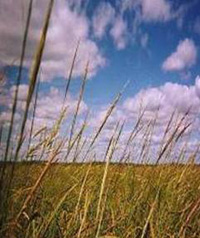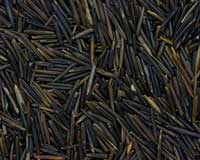Wild Rice Recipes
Chopped Salad with Wild Rice
Stuffed Turkey
Turkey Cranberry Salad
Wild Rice
Wild Rice and Black Beans
Pair Wild Rice With...
Cumin Trout
Halibut
with Rosemary Maple Glaze
Roasted Turkey Breast
Pictures

Wild rice stands.

Wild rice.
Ingredient Information
Wild Rice
I adore wild rice. It has a great nutty flavor that's different from almost any other grain. It's terrific because it adds so much variety to your recipes and works so well with almost any other ingredient. You can serve it by itself or with conventional rice, lentils or corn. It makes great salads and is wonderful in soup.
There are a number of types of wild rice on the market and it's a good idea to look carefully at the package to know what you're getting. Like conventional rice, wild rice comes in a variety of lengths including long, medium and short grain.
Black wild rice is essentially the whole grain, having most of the bran layer in place. As a result the rice will take longer to cook -- about 45 minutes -- and be chewier when finished.
Brown wild rice has had some of the bran layer removed and consequently cooks in less time, taking only about 30 minutes. It is not as chewy as black wild rice and the wild flavor is not as strong.
Blond wild rice has had most of the bran removed. It cooks quickly - in about 15 - 20 minutes. I'm not as fond of blond varieties because there's a loss of much of the wild nutty flavor.
Most wild rice comes from one of three areas. In the U.S. rice is grown in both in the upper Midwest and in California. For the most part California rice is cultivated and is fatter and longer. Other American rice is shorter and thin and is both harvested wild as well as from cultivated rice farms. Canadian rice is long and thin and, like that in the Midwest, both harvested wild and cultivated.
Wild rice is technically not a rice but the seed of the grass Zizania palustris. The grass grows in lakes predominantly in the northern states of the U.S. and Canada. Traditionally known as “manoomin” and long harvested by Native Americans, much of our knowledge of the cycle of growth and collection comes from the Ojibwe. Ricing is the term used for collection, being traditionally done in canoes by gathering the tops of the grass and beating the seed into the flat bottom of the boat.
 When I purchase rice I will generally buy both black and brown
varieties and have both in my pantry. I do particularly love the
Native Harvest brand of hand harvested rice from the White Earth
Indian Reservation in Ogema, MN. I found this brown wild rice originally
at the National Museum of the American Indian and have since been
ordering it online at www.nativeharvest.com. I also enjoy the popular
brand from the Lundberg family farms in California. Their black organic
wild rice is particularly good. Both of these brands are a little
more expensive but the quality is consistently good.
When I purchase rice I will generally buy both black and brown
varieties and have both in my pantry. I do particularly love the
Native Harvest brand of hand harvested rice from the White Earth
Indian Reservation in Ogema, MN. I found this brown wild rice originally
at the National Museum of the American Indian and have since been
ordering it online at www.nativeharvest.com. I also enjoy the popular
brand from the Lundberg family farms in California. Their black organic
wild rice is particularly good. Both of these brands are a little
more expensive but the quality is consistently good.
1/4 cup raw wild rice = 143 calories, 0 g fat, 0 g sat fat, 0 g mono fat, 6 g protein, 30 g carbohydrates, 3 mg sodium, 0 mg cholesterol, Vitamin K 1 mcg.
